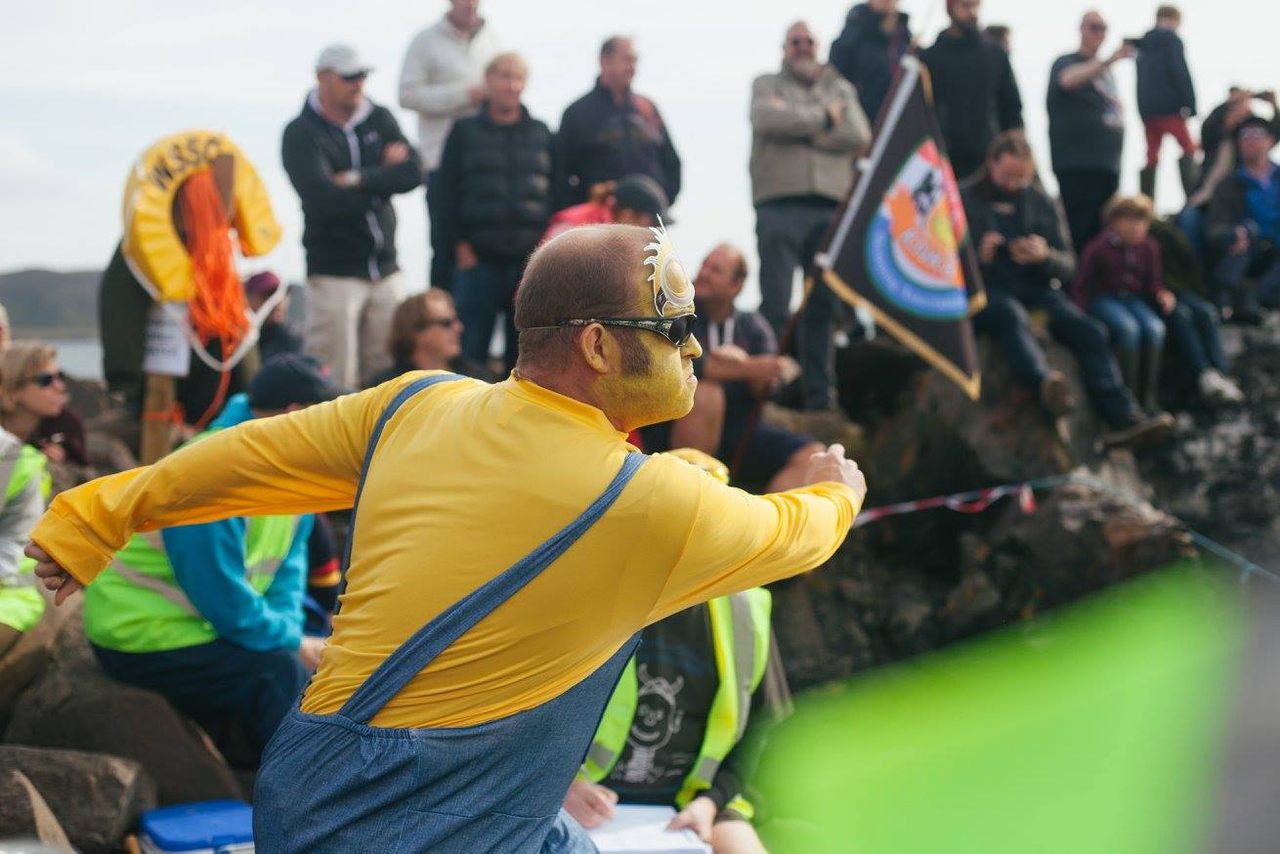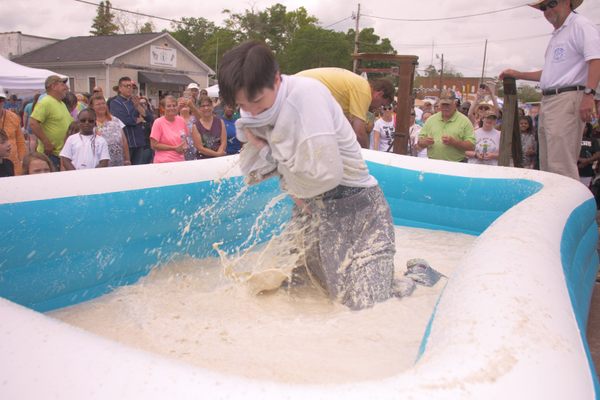Stone Skimming Is a World Champion Sport—And a Model for Spaceships
What to know if you want to skip a rock over 200 feet. Or fly to space.
Alex Lewis has spent many evenings searching for and gathering 100 rocks. After collecting various shapes and sizes from the west coast of Scotland, he returns home, numbers each from one to 100, weighs them, and measures their width and thickness. He’s looking for stones that fit comfortably in his palm, are heavy and light, and vary from circular to square. He then records all his data in a little black book full of tables and near indecipherable calculations.
“I created something called the WH formula where I divide width over height” Lewis says, showing a series of complex charts. “I’ve tested different thicknesses and widths to find out which one does best for skips and for distance.”
He then takes those rocks to the coast and throws every single one into a lagoon. He records how far each stone travels along the surface of the water.
Lewis is the three-time British Stone Skimming champion. Extensive testing and experimentation have ensured that he has a solid idea of the best stone to throw in almost any conditions. He prefers heavier stones for wind or stormy waters and lighter stones for a calm day. Square stones are acceptable, though his favorite shape is triangular, so he can catch his finger on the edge and maximize spin. All rounded rocks are rejected.

Across the British Isles in London, Lucy Wood, the record holder for women’s World Championship wins, scavenges the banks of the Thames for rocks and remnants of bricks. She’s not very interested in data collection and instead feels what works intuitively. You can often find her here, launching the rocks across the river while trying to avoid passing boats.
“I love being outside,” she explains simply. “I can really appreciate the beauty of a good skim in a beautiful setting; it’s a lovely, fleeting moment.”
Lewis and Wood are both practicing for the Stone Skimming World Championships, an event held on the small Scottish island of Easdale. The goal is simple: skim a stone across a body of water as far as possible. Anyone who reaches the back wall of the quarry, 63 meters (206 feet) from shore, is rewarded with a klaxon horn, a huge cheer from the crowd, and qualification for the Toss Off: the grand finale of the competition.
This might sound like all fun and games, but it turns out there’s a lot more skill and complex considerations involved, branching into geology and physics. And while the championship has become increasingly serious for competitors, the research behind stone skimming is also serious business. Studies of the sport have led to advancements in science—including space missions.
For Lewis and Wood, though, it’s about one day.

“The idea, like all great ideas, came out of a conversation in the local pub,” says Kyle Matthews, an Easdale local and one of the event’s organizers. “The islanders thought it’d be something fun to do.”
That first contest took place in 1983. At the time, it was the “World” Championships in little more than name. Around fifteen locals turned up and threw some stones into the quarry for a laugh.
Perhaps because no one took it too seriously, a 14-year hiatus followed the first championship. Then, in 1997, a local organization resuscitated it as a fundraising event for the community. It was a major success. This time, around 60 people showed up and a 55-meter (180-foot) throw won the overall event. Since then, the competitions have been held annually, growing each year and marking longer and longer distances. In 2002, Alistair Judkins hit the back wall of the quarry with a throw of 63 meters (208 feet).
Since then, the back wall has become the goal of all skimmers at the World Championships. Some say there’s something about the quarry that makes this a near impossible task. The 63-meter mark is almost half the distance of the world record, which is currently 121.8 meters (399 feet) for a natural stone. But even the record holder and eight time World Champion, Dougie Isaacs, struggles to repeatedly hit the back wall at Easdale. Some theorize that the tidal patterns play a part, others have more mystical explanations about the energy of the place.
After the ubiquitous pandemic pause, 2023 is the first year the championships have returned to Easdale in Scotland’s Inner Hebride. It might seem strange to hold a worldwide competition on an island that takes about 20 minutes to walk around, is only accessible by a small passenger boat, and holds a population of about 60. That is, until you realize that amid Easdale’s whitewashed cottages lies some old, vast slate quarries.

Now defunct, these abandoned quarries are permanent reminders of the island’s past as the center of the Scottish slate industry, once heralded for roofing homes across the world. A particularly brutal storm in 1881 destroyed the walls of the quarries, filling them with water and rendering them unusable. Now at these sites, dark walls of deep gray rock meet turquoise and navy blue waters, surrounded by bits of slate.
Anyone who is familiar with slate could instinctively tell you that it’s a particularly good rock for skimming. As it turns out, there are geological reasons for that.
“The slates that are found at Easdale and elsewhere in Scotland were originally sediments laid down in the sea probably around 600-730 million years ago,” explains Iain Neill, lecturer in Magmatic Processes at the University of Glasgow.
Over a series of lengthy processes, the rock changed chemistry from mudstone and shale to recrystallising into stronger minerals. When slate forms, it does so in layers. When broken, it splits along these lines, leaving thin sheets of rock with flat surfaces that can comfortably bounce across water.

The shape of the stone further impacts the throw, as different shapes will interact with the surface of the water in unique ways. Childhood experimentation has taught many of us that flat rocks are superior, but this isn’t necessarily true.
“Maybe if you’re looking to get lots of sort of tiny skips out of a rock, the old convention of a flatter rock still stands,” says Dr. Ryan Palmer, researcher at the University of Bristol and co-author of a recent paper on skimming motions. “But a greater range of rocks can have these skimming motions if the conditions are right—and it can lead to some quite exotic jumps and trajectories.”
So even a bulbous rock can be bounced off the water with a good throw.
Granted, other stone skimming competitions (like the Welsh Open) are starting to use artificial stones, arguing that they ensure a level of consistency and a fair playing field for competitors. But some still prefer natural stones. “There’s a romanticism there,” says Wood. “Selecting a stone is a part of the event.” Luckily, Easdale has a plethora of good slate options.

Even the perfect stone, though, isn’t a silver bullet—physics is another big factor.
In order for rocks to bounce on top of water, seemingly magically, the stone has to be traveling fast enough to meet a minimum velocity threshold, otherwise it will sink. The angle also has to be just right, between about 10 and 20 degrees between the stone and the water. The rock also has to be spinning. Researchers call it a minimum state of rotation, or the ‘gyroscopic effect’.
This spin helps stabilize the stone, but gravity still pulls it down. The stone loses energy when it hits the surface of the water, but it also pushes the water down and therefore exerts a lift force against the surface, which makes a rebound possible.
But the study of stone skimming goes far beyond the champion’s furthest throw. These same principles have been used in surprising ways throughout history. An English mathematician named William Bourne noted in 1578 that, if angled correctly, shooting cannons at water could result in the cannonball ricocheting off the surface to hit intended ships.
This also helped the British develop Bouncing Bombs in the second world war. As the name suggests, these weapons bounce off the water to hit their target, thereby avoiding underwater defenses such as torpedo nets.
Skimming has even wider applicabilities, though, and ones not just limited to earth.

Physicists studied the sport in 2021 in order to determine the best landings for spaceships. Studies had already been done, as far back as 1929, about how these physics help us understand aircraft water landings. And while the same knowledge is helpful for when spacecraft also land on water, spaceships can act like a skipping stone when bouncing not just against water, but also against the atmosphere of the Earth.
“The Russians did that, actually, in the ‘60s,” says Michael Khan, a mission analyst at the European Space Agency. “They designed the entry trajectory such that the atmosphere was skimmed first. The craft left the atmosphere at a low altitude, slowed down, and then a few thousand kilometers further on, it reentered the atmosphere again to land.”
Skimming, at its core, is concerned with the interaction of an object (like a stone) between two mediums (like water and air). When the object is a space shuttle, it interacts with the interplanetary medium (which is like the space between planets) and the Earth’s atmosphere.

As when aiming a stone, targeting the angle is critical. Diving too steeply can create too much friction, causing the spacecraft to burn up. On the other hand, as Khan explains, “if you don’t target deep enough into the atmosphere, then you don’t slow down enough,” meaning the spacecraft could almost bounce back out into space. What the Russians did in the 1960s was hit the Earth’s atmosphere at just the right angle to achieve a bounce briefly back into space, before coming back down again to the atmosphere. “Skimming has been done; it’s been part of a successful mission,” Khan concludes.
Some think the skimming potential can be further harnessed; a space shuttle with wings might even be able to target entry to the atmosphere to deliberately rebound on a different trajectory. In other words, a spaceship could skim the atmosphere to change orbit. And there’s excitement about the possibility of atmospheric skimming, in which spacecraft could take advantage of atmospheric drag to break a craft entering the atmosphere from the interplanetary medium.
Back in Scotland, are the competitors at the World Stone Skimming Championships concerned with bouncing weapons and spaceship landings?
“I actually contacted NASA,” Lewis admits. “Apparently the outside of their rockets are made out of some incredibly Teflon-like material, so I thought I could make some artificial stones out of them. But they never got back to me.”
He is, however, convinced there are still areas in which stone skimming research can make a difference. “I think NASA has some far smarter people working on their issues!” he assures—but if anyone wants to see the data and discuss, he’s ready to share all his calculations. For now, his main focus is on the World Championship title.

At the end of the event, Lewis stands ready for the grand finale Toss Off. Having qualified with his previous throws, he now steps up for the final round. A hush falls over the crowd. Each contestant has three stones, and the highest cumulative distance takes the win.
On his turn, Lewis steps up to the water, licks his finger to maximize friction, grips his stone tightly as he turns to the side, and winds his right arm back before flinging the stone across the surface of the water. It bounces 57 meters (187 feet)—good, but not yet enough to secure the win. The next one reaches 56 meters (183 feet). But things take a devastating turn as his third throw is disqualified.
A cumulative total of 113 meters (370 feet) ensures Lewis second place, but it’s 16-year-old Finn Dower who takes home the title this year, with a cumulative score of 170 meters (557 feet). He’s the youngest-ever winner, shaking up the world of stone skimming to rapturous applause from the crowds. They might have come out for the legends of the sport, but everyone loves an underdog.
When the last stone of the competition falls and the event closes for another year, perhaps that rock sinks in the water like a spaceship descending through the Earth’s atmosphere. Maybe an onlooker thinks about this. Maybe it’ll spark a revelation that one day revolutionizes spacecraft design. Maybe.























Follow us on Twitter to get the latest on the world's hidden wonders.
Like us on Facebook to get the latest on the world's hidden wonders.
Follow us on Twitter Like us on Facebook